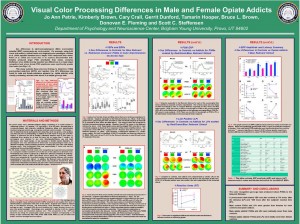Scott C Steffensen, Psychology
Completion of Academic Objectives
The primary objective of this MEG project was to develop a non-invasive treatment for drug addiction. It was the first aim of this study to determine, in controlled experiments in rodents, the efficacy of brain electrical or light stimulation to produce long-term enhancement of dopamine (DA) release. Then, second, in a known human model of transient DA deficiency in drug-free subjects, which we already have recent experience, we will evaluate the effects of this stimulation to ameliorate the physiological and cognitive deficits that we have seen. When an addict refrains from their addictive behavior DA levels fall in the mesolimbic DA reward system in the brain below normal homeostatic levels creating a powerful motivating force to return to their previous addictions to raise the levels of DA, avoiding the dysphoria, anxiety and perhaps depression associated with withdrawal. Thus, if the tonic levels of DA in the reward system could be restored to baseline or normal levels before such a critical point of deficiency, then relapse, and the associated societal impacts could be avoided. Non-invasive brain stimulation to enhance DA levels has much promise in this regard. By monitoring dopamine levels a medical practitioner in private practice could effectively treat subjects by raising their DA levels via brain stimulation, which would effectively diminish the hedonic valence of the drug reinforcer and lower relapse rates.
We have made considerable progress on the study. However, because of our findings in studies associated with the first Aim the second Aim involving human subjects was put in abeyance. One paper has been published as a direct result of this work:
Yorgason, J., Ferris, M., Steffensen, Scott, Jones, S. Frequency Dependent Effects of Ethanol on Dopamine Release in the Nucleus Accumbens. Alcoholism, clinical and experimental research (2013) 37 (Epub ahead of print)
Another paper is currently under review which involved two BYU graduate students and one undergraduate student:
Schilaty, N.D., Hedges, D.M., Jang, E.Y., Folsom, R.J., Yorgason, J.T., McIntosh, J.M., Steffensen, S.C. Acute ethanol inhibits dopamine release in the nucleus accumbens via α6 nicotinic acetylcholine receptors. JPET (2013) Under review
In addition, we presented our findings related to the MEG (i.e., DA release studies) at the Research Society on Alcoholism and Society for Neuroscience Meetings in 2012 on this work. Another 3 graduate students and 4 undergraduate students presented their findings, which were also published in abstracts:
Steffensen, S.C., Schilaty, N.D., Jones, S.R., and Yorgason, J.T. Role for GABA(A) receptors in ethanol inhibition of evoked dopamine release in the nucleus accumbens. Proceedings of the 10th International Catecholamine Symposium 10 (2012) 92.
Hansen, D.M., Yorgason, J.T., Wilcox, J.D., Konstantopoulos, J.K., Hedges, D.M., Jones, S.R., and Steffensen, S.C. Effects of D2 type autoreceptor antagonists on ethanol-induced inhibition of dopamine release in the nucleus accumbens. Soc. Neurosci. Absts 37 (2011) 373.07
Hansen, D.M., Wilcox, J.D., Yorgason, J.T., Jones, S.R., and Steffensen, S.C. Effects of D2-type autoreceptor antagonists on ethanol-induced modulation of dopamine release in the nucleus accumbens. Alcoholism: Clin. Exp. Res. (2011) 35(6) 65A(0218)
We have filed two provisional patents in connection with the work that resulted from this MEG. This MEG grant has helped me to take 5 graduate students and 8 undergraduate students to these International Scientific Conferences in 2012, to work on potential commercial projects not covered by my existing NIH grants, and to secure two large NIH grants. In addition to helping pay the stipends of a few students in the lab and travel funds for more than a handful to attend these Conferences the MEG grant has enabled me to mentor more undergraduates. Indeed, 30 undergraduate students worked in my lab in 2012. Because of the experience in my lab they can see that there is a future in academia and research, and that it looks bright, in fact so bright that they are choosing this direction instead of the more lucrative professional school direction. I hope that they have seen in me the hope I have for their future in research. I hope that they have seen in me the joy I have in discovery. More and more schools demand this mentoring experience, if not highly recommend it. It’s what makes them stand out from the fray. I’m relatively certain that BYU’s visionary emphasis on undergraduate mentoring, ORCA grant support, and my continuing NIH funding has played a pivotal role in the ability of these students to achieve their career goals, which are generally lofty, gainful, and of high quality. Regarding ORCA grant support, 7 of my undergraduate students were awarded ORCA grants in 2012. The are: Jennifer Blanchard, Adam Smith, Peter Nielson, Andrew Welch, Ben Carter, Sam Shin and Michael Munafo. Two of these students are currently finishing up Master’s degrees here at BYU, two are in medical school and the rest are applying for graduate or professional schools. Finally, I have vested interest in the future of our students. I recommend them for positions after graduation. I write letters of recommendation for most of them. I even employ them. For example, I have employed nine former Neuroscience students as Faculty Research Associates on a full-time basis. My only concern I have regarding mentoring is to try to identify students early on in their undergraduate experience who might have an interest in research. I really need two years with them to get them to a position wherein they can make a meaningful contribution to the laboratory and perhaps to the world. I need that time to develop an effective relationship with them such that a reciprocal trust is developed. Then, I am in a better position to write well-developed and strong letters of recommendation for their post-graduate pursuits.
I have pasted below images of our posters presented at Scientific Conferences in 2012 that are directly related to the Aims of this ORCA MEG. Thanks again for your support. Fall 2011 Mentoring Environment Grant (MEG) Application Page 3 D 1 Fall 2011 Mentoring Environment Grant (MEG) Application Page 4


